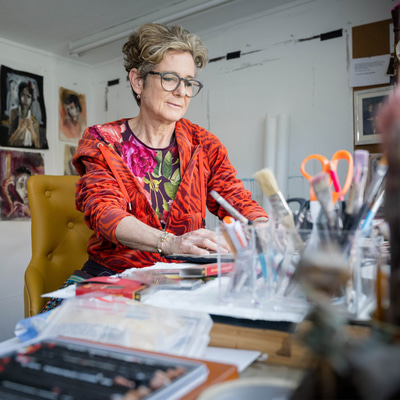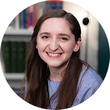- OT
- Industry
- Eyewear and lenses
- “Wearing glasses is really important to me from a fashion perspective”
Me and my glasses
“Wearing glasses is really important to me from a fashion perspective”
Rachel Gadsden, visual and performance artist and disability cultural activist, on jazzy eyewear, low vision services, and the importance of drawing to express identity

16 October 2023
How many pairs of spectacles or sunglasses do you own?
I have had lots of glasses. Wearing glasses is really important to me from a fashion perspective. Partly because I’m an artist and I want them to look jazzy, but not to the extent that they enter a room before me. I go to huge trouble to look for a pair of glasses I might like.What frame shapes, colours or styles do you usually go for?
I often go for autumnal colours. But not necessarily – if I see something I really like, then I buy them. I’ve worn a lot of Ray-Bans. I like tortoiseshell, but they don’t have to be brown; I've had purple and blue versions.I have several pairs of glasses because of an eye condition. I have some with prisms in, that I wear at the computer, others for when I’m standing and painting, and others that I walk around in. For my condition, something like a varifocal isn’t satisfactory, and I can’t wear sunglasses because it diminishes my sight further. That means I change my glasses depending on what I’m doing. I also have a lot of allergies, including a metal allergy, so nose pads must be built into the frame.
Can you describe your favourite pair?
Rachel's style
Tortoiseshell is a favourite style, but in any colour combination, including blues and purples
How long have you worn spectacles for? What prompted you to go for the sight test that led to this?
I have a condition called retinoschisis. It’s often inherited, and boys are more likely to develop it than girls, so they don’t really know why it’s come up, but they knew something was wrong with my central vision. I've had huge amounts of medication because of a life-long lung condition, and this includes steroids, which affect your eyes. Ultimately, the diagnosis was retinoschisis.
I’ve never seen clearly. We didn’t go to the optometrist when we were younger, and I just got on with it and learned to see the way I saw. But when things deteriorated, my brain couldn’t fathom the change. I was probably around 40. I was in hospital and had needed to be resuscitated. I couldn’t see the television at the end of the bed and thought I needed glasses.
The fact that I’ve had this incredible support from low vision clinics and optometrists is extending my ability to make the work I make. It’s vital
At the beginning it was terrible; I earn my living as a visual performance artist. I ended up at Moorfields. Once you see a low vision optometrist, they have a lot of things they can suggest to help you see more. I've been under a lot of low vision centres where you can get support, adaptations, and computers. The fact that I’ve had this incredible support from low vision clinics and optometrists is extending my ability to make my work. It’s vital.

What does vision and eye health mean to you?
I was first registered as visually impaired, and then as severely visually impaired. Though it would be wrong to say that I can’t see anything, because I can.
Change maker
Rachel was part of Roche’s 2021 campaign raising awareness of the realities of vision loss
I'm lucky because, as an artist, I already had a very acute visual awareness. While what I see through my eyes has diminished, my sense of visual awareness has always been there. After I got through the shock of it all, I learned that vision isn’t just to do with your eyes. It's part of something much bigger. If you think of how we recognise people we know from a distance while we still can’t see them clearly, perhaps from the way they walk, you realise that your brain is doing loads of the work. I accept that I don’t see the way other people see.
If someone complains to me about their eyes, I always tell them: “Go to your optometrist.” If they then try to tell me that their eyes are ‘fine,’ I’ll tell them: “How do you know they are fine? At least the optometrist will check your eye health out, do it for that alone if nothing else.”
My husband is very short sighted, which can sometimes mean it is easier to get a detached retina. He noticed something was wrong. Most people would probably leave it, and by the time they have a major problem, it can be difficult to try and save their sight. Within 24 hours, he had gone to Moorfields A&E, and they were able to do a laser treatment. If people know, then they can save their precious sight.
How important is eyewear to reflecting your personality?
When I first started wearing glasses all the time, I used to wear those rimless ones. Partly because I think I almost didn’t want people to see that I was wearing glasses. The glasses were often tiny, and because I have quite a vigorous practice, I was always knocking them off my face. So I swapped over. Since then, frames have changed and become a fashion item. They are really important. I always go through the sunglasses section to see what is there because they can often have a more expressionist style.
What are your top three tips for selecting the right pair of frames?
- Show your personality. Glasses are as important as the t-shirt you wear
- Don't let your glasses walk into the room before you do
- Choose whatever it is you love. Not what you think others will.
Expressing identity through drawing, and not dwelling on ‘can’t’
OT asked Rachel about this year’s theme, advice on drawing, and learning from setbacks.

What does the theme of The Big Draw, Drawing with the senses, mean to you?
I’m a disability activist and my practice encompasses social engagement projects where I work and collaborate with disabled and mainstream people. I’ve always felt that through the process of drawing, your own individual identity and voice emerges.The Big Draw often isn’t just about picking up a pencil. I draw through my body. Before I received my eyesight diagnosis, I studied Anatomy for Artists and learned all about how the body articulates. Now whenever I am drawing people, I use my physical being to stand in that shape and think about how I will draw. I’m almost seeing through my body, not necessarily my eyes. The senses play a huge part in why we create art.
Everybody was really excited by the theme. What I am hoping is that people push the boundaries of it as much as they can.
This year I was commissioned to go to Holland as the international artist for The Big Draw Netherlands. I exhibited my art at Museum Arnhem and in September I performed TransHuman in Arnhem and Nijmegan. I also led a workshop with young people who have visual impairment, to push the boundaries of how they draw with the sight they have.
Would you have any words of encouragement for those who feel they ‘can’t draw’?
I come from the school of thought that everybody can draw. People think that good drawing is making something look like what it is supposed to look like. For me, it’s about drawing something that has creativity. We can take a photograph and make it look like what it needs to look like, but through drawing, you can make it whatever you want it to be.What is your approach to learning from when things go wrong?
You can imagine how competitive the art world is. I learned early on to get over failure quickly. Even now, you go for a commission, and it doesn’t always work out, but luckily many have. My approach is not to dwell on what I can’t do, but on what I can do. I was told early that if you want to get to a certain point in your career, the only way you will get there is if you go and get it. Life is not easy. But you have to try and find your little way forward, whatever that needs to be.


Comments (0)
You must be logged in to join the discussion. Log in